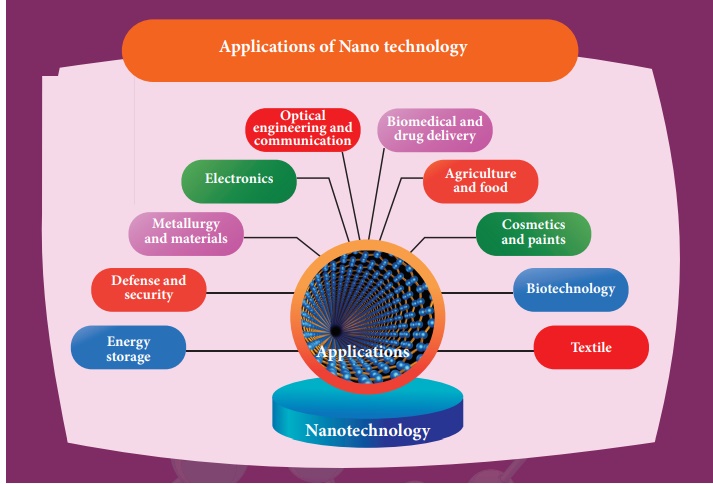Recent Developments in Physics - Nanoscience and Nanotechnology | 12th Physics : UNIT 11 : Recent Developments in Physics
Chapter: 12th Physics : UNIT 11 : Recent Developments in Physics
Nanoscience and Nanotechnology
Nanoscience and Nanotechnology
Nanoscience
Nanoscience is the study of structures and materials on the scale of nanometers. Nano means one-billionth of a meter that is 10-9 m.
If matter is divided into such small objects the mechanical, electrical, optical, magnetic and other properties change.
Nanotechnology
Nanotechnology is a technology involving the design, production, characterization, and applications of nano structured materials.
Nanoparticles
The solids are made up of particles. Each of the particle has a definite number of atoms, which might differ from material to material. If the particle of a solid is of size less than 100 nm, it is said to be a 'nano solid. When the particle size exceeds 100 nm, it is a 'bulk solid. It is to be noted that nano and bulk solids may be of the same chemical composition. For example, ZnO can be both in bulk and nano form. Though chemical composition is the same, nano form of the material shows strikingly different properties when compared to its bulk counterpart.
In the nano scale dimensions (reduced dimensions), two important phenomena govern nano properties. They are quantum confinement effects and surface effects. Students can explore these effects in higher education and the explanation is avoided at school level.
Interdisciplinary nature of Nanotechnology
Nanoscience and technology is the interdisciplinary area covering its applications in various fields
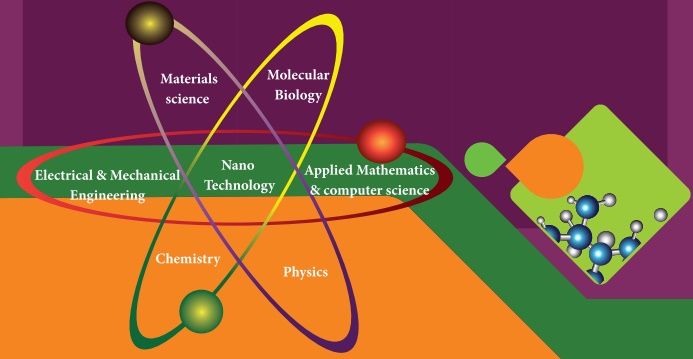
• Materials science
• Molecular Biology
• Electrical & Mechanical Engineering
• Nano Technology
• Applied Mathematics & computer science
• Chemistry
• Physics
Nano in Nature
Nanoscale structures existed in nature long before scientists began studying them in laboratories.
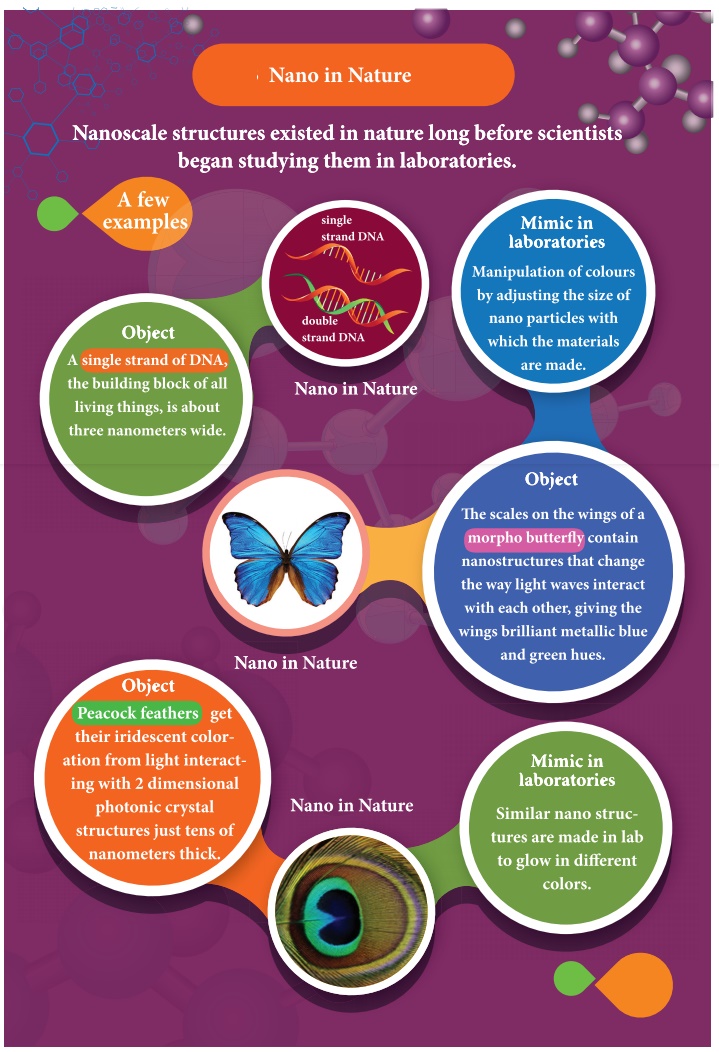

A few examples
Object
A single strand of DNA, the building block of all living things, is about three nanometers wide.
Nano in Nature (single strand DNA, double strand DNA)
Nano in Nature (morpho butterfly)
Object
The scales on the wings of a morpho butterfly contain nanostructures that change the way light waves interact with each other, giving the wings brilliant metallic blue and green hues.
Mimic in laboratories
Manipulation of colours by adjusting the size of nano particles with which the materials are made.
Nano in Nature (Peacock feathers)
Object
Peacock feathers get their iridescent color ation from light interact ing with 2 dimensional structures just tens of nanometers thick.
Mimic in laboratories
Similar nano struclures are made in lab to glow in different colors.
Nano in Nature (Parrot fish)
Parrot fish crunches up coral all day. The source of the parrotfish's powerful bite is the interwoven fibre nanostructure. Crystals of a mineral called fluorapatite are woven together in a chain mail-like arrangement. This structure gives parrotfish teeth incredible durability.
Mimic in laboratories
The natural structure provides a blueprint for creating ultra-durable synthetic materials that could be useful for mechanical components in electronics, and in other devices that undergo repetitive movement, abrasion, and contact stress.
Nano in Nature Lotus leaf surface
Object
Lotus leaf surface Scanning electron micrograph (SEM) showing the nano structures on the surface of a leaf from a lotus plant. This is the reason for self cleaning process in lotus leaf.
Mimic in laboratories
Water repellant Nano paints are made. Coating with such nano paints give durability, protection against stains and dirt also enhances fuel efficiency when coated on ships.
Early beginning and development (Not for examination)

2016
Jean-Pierre Sauvage, J. Fraser Stoddart, and Bernard Feringa won the Nobel Prize in Chemistry for their research in developing Nano-scale machines including a 'nanocar
2004
2D material was isolated and characterized in 2004 by Andre Geim and Konstantin Novoselov at the University of Manchester. This work won the Nobel Prize in Physics in 2010.
1990's - 2000's
Research groups and com mitees were formed to drive nano-related research. Consumer products making use of nanotechnology began appearing in the marketplace.
1981
Gerd Binning and Heinrich Rohrer developed the scanning tunnelling microscope (STM), that modern nanotechnology began. The STM allowed researchers to view atoms on the surface of materials for the first time ever, and since then nanotechnology began its gradual growth.
1989
Don Eigler and Erhard Schweizer at IBM's Almaden Research Center manipulated 35 individual xenon atoms to spell out the IBM logo. This demonstration of the ability to precisely manipulate atoms ushered in the applied use of nanotechnology.
1974
While working on the development of ultra-precision machines, Professor Norio Taniguchi coined the term nanotechnology.
1959
The ideas that define nanoscience and nanotechnology were men tioned long before the terms were coined, in a lecture by American physicist Richard Feynman "There's plenty of Room at the Bottom" in 1959. Feynman described processes that would allow scientists to manipulate and control individual atoms and molecules.
Nano in laboratories
The nanostructures made in the laboratory mimic some of nature's amazing nanostructures. As the nanostructures are so small, specialized methods are needed to manufacture objects in this size range. There are two ways of preparing the nanomaterials, top down and bottom up approaches.
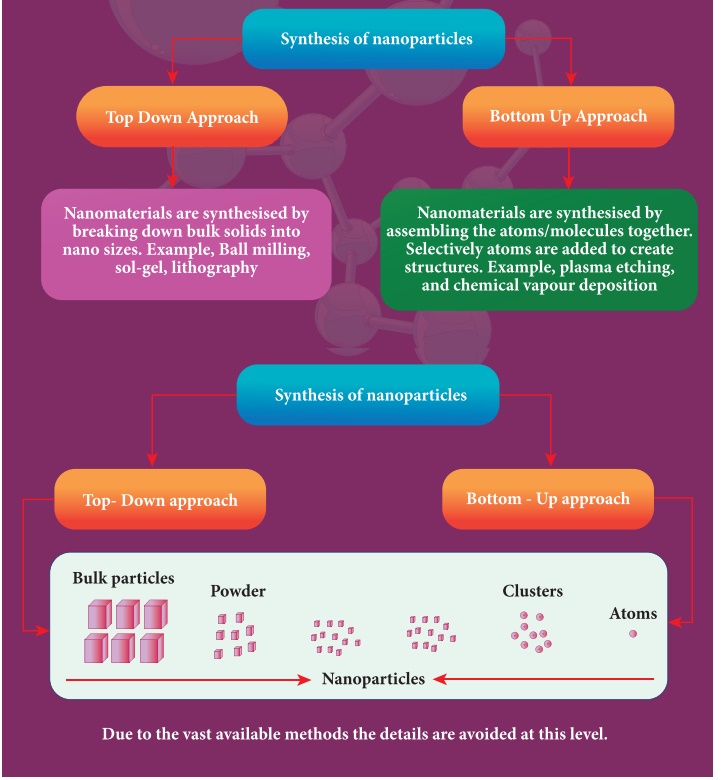
Synthesis of nanoparticles
Top Down Approach : Nanomaterials are synthesised by breaking down bulk solids into nano sizes. Example, Ball milling, sol-gel, lithography
Bottom Up Approach: Nanomaterials are synthesised by assembling the atoms/molecules together. Selectively atoms are added to create structures. Example, plasma etching, and chemical vapour deposition
Synthesis of nanoparticles
Bottom - Down approach
Bottom - Up approach
Applications of Nano technology
• Optical engineering and communication
• Electronics
• Metallurgy and materials
• Biomedical and drug delivery
• Agriculture and food
• Cosmetics and paints
• Defense and security
• Biotechnology
• Energy storage
• Applications
• Textile

Applications of nanomaterial based products in different areas
Automotive industry
• Lightweight construction
• Painting (fillers, base coat, clear coat)
• Catalysts
• Tires (fillers)
• Sensors
• Coatings for wind- screen and car bodies
Chemical industry
• Fillers for paint systems
• Coating systems based on nanocomposites
• Impregnation of papers
• Switchable adhesives
• Magnetic fluids
Engineering
• Wear protection for tools and machines (anti blocking coatings, scratch resistant coatings on plastic parts, etc.)
• Lubricant-free bearings
Electronic industry
• Data memory
• Displays
• Laser diodes
• Glass fibres
• Optical switches
• Filters (IR-blocking)
• Conductive, antistatic coatings
Construction
• Construction materials
Thermal insulation
• Flame retardants
• Surface-functionalised building materials for wood, floors, stone, facades, tiles, roof tiles, etc.
• Facade coatings
• Groove mortar
Medicine
• Drug delivery systems
• Active agents
• Contrast medium
• Medical rapid tests
• Prostheses and implants
• Antimicrobial agents and coatings
• Agents in cancer therapy
Textile/fabrics/ non-wovens
• Surface-processed textiles
• Smart clothes
Energy
• Fuel cells
• Solar cells
• Batteries
• Capacitors
Cosmetics
• Sun protection
• Lipsticks
• Skin creams
• Tooth paste
Food and drinks
• Package materials
• Storage life sensors
• Additives
• Clarification of fruit juices
Household
• Ceramic coatings for irons
• Odors catalyst
• Cleaner for glass, ceramic, floor, windows
Sports/ outdoor
• Ski wax
• Antifogging of glasses/goggles
• Antifouling coatings for ships/boats
• Reinforced tennis rackets and balls
Possible harmful effects of nanoparticles
The research on the harmful impact of application of nanotechnology is also equally important and fast developing. The major concern here is that the nanoparticles have the dimensions same as that of the biological molecules such as proteins. They may easily get absorbed onto the surface of living organisms and they might enter the tissues and fluids of the body.
The adsorbing nature depends on the surface of the nanoparticle. Indeed, it is possi- ble to deliver a drug directly to a specific cell in the body by designing the surface of a nanoparticle so that it adsorbs specifically onto the surface of the target cell.
The interaction with living systems is also affected by the dimensions of the nanopar- ticles. For instance, nanoparticles of a few nanometers size may reach well inside biomolecules, which is not possible for larger nanoparticles. Nanoparticles can also cross cell membranes. It is also possible for the inhaled nanoparticles to reach the blood, to reach other sites such as the liver, heart or blood cells.
Researchers are trying to understand the response of living organisms to the pres- ence of nanoparticles of varying size, shape, chemical composition and surface characteristics.
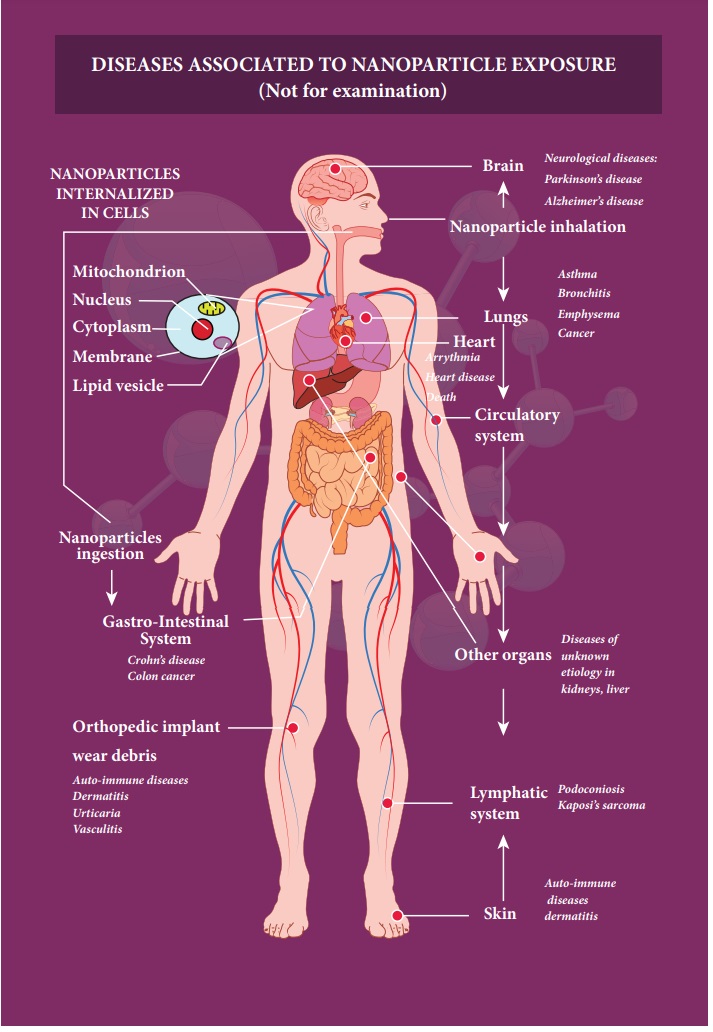
Related Topics
